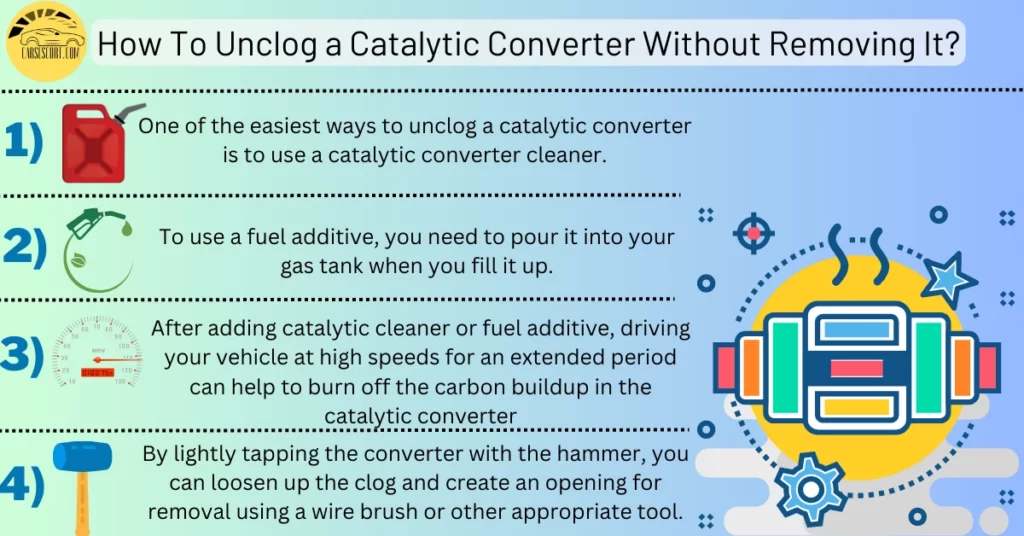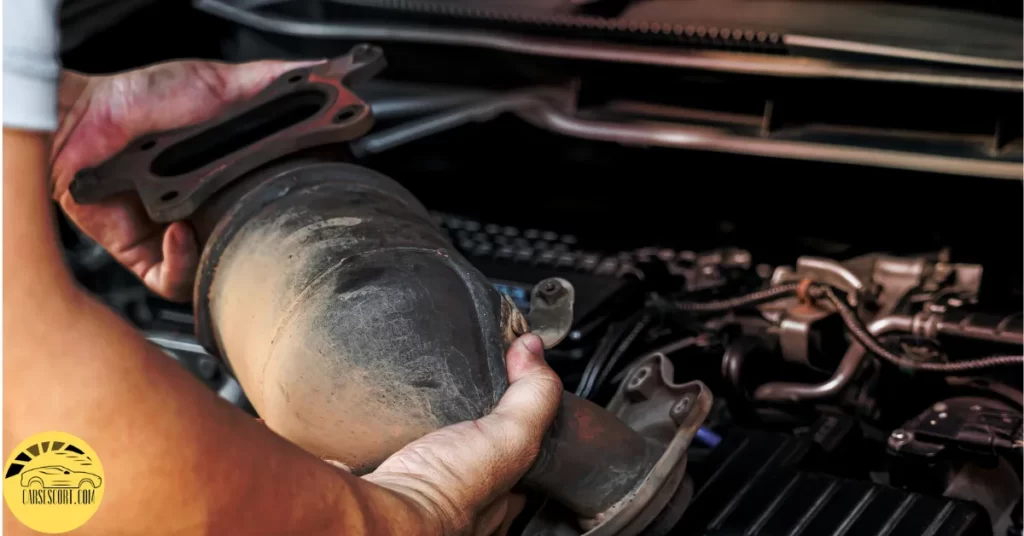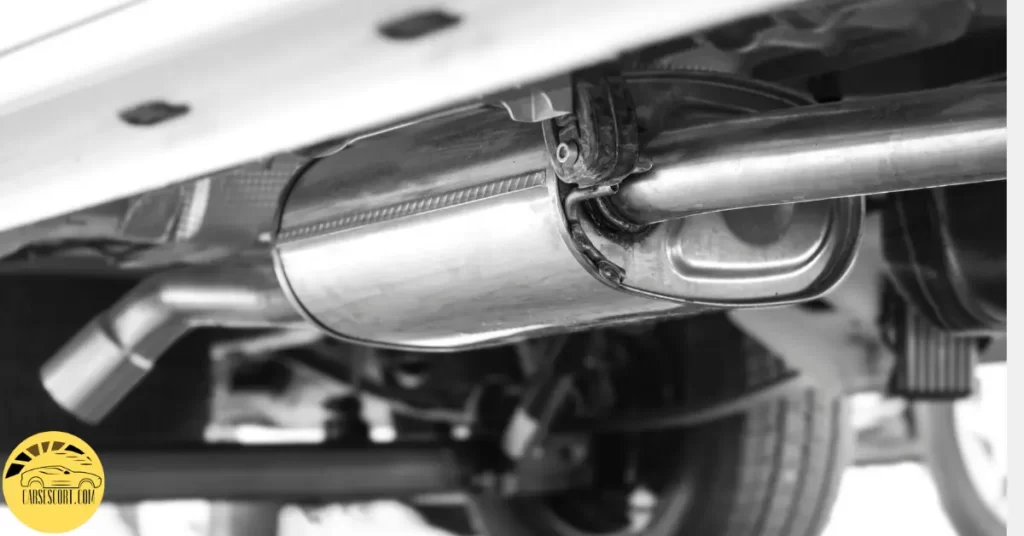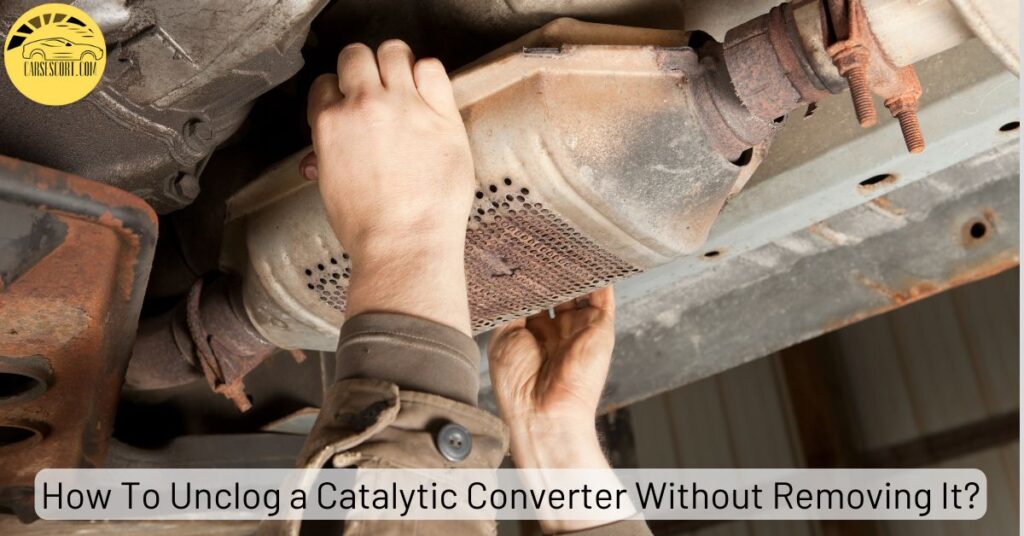The easiest way to unclog a catalytic converter without removing it is to use a catalytic cleaner. Pour the cleaner into a half-full fuel tank, wait 2 minutes and then drive your car at approximately 2500 RPMs for at least 30-40 minutes to clean the catalytic converter.
If you’re experiencing a decrease in your car’s performance or fuel efficiency, it may be due to a clogged catalytic converter. A catalytic converter is among the essential components of your car’s exhaust system, which helps to reduce harmful emissions. However, over time, it can become clogged with carbon buildup, dirt or debris, leading to decreased engine performance.
While the traditional solution to a clogged catalytic converter is to remove and replace it, this can be expensive and time-consuming. Fortunately, several effective methods exist to unclog a catalytic converter without removing it.
4 Easy Ways To Unclog A Catalytic Converter Without Removing
- Use a Catalytic Converter Cleaner.
- Add a fuel additive to your gas tank.
- Driving your vehicle at approximately 2500 RPMs.
- By lightly tapping the converter with the hammer.

Signs of a Clogged Catalytic Converter
- Decreased engine performance
- Reduced fuel efficiency
- Rough idle and compromised fuel and oil systems.
- Check engine light
- P0420 Code
- Unusual smell
How To Unclog a Catalytic Converter Without Removing It?
Method #1: Use a Catalytic Converter Cleaner
One of the easiest ways to unclog a catalytic converter is to use a catalytic converter cleaner. This type of cleaner is designed to break down the debris and carbon buildup inside the converter, restoring its effectiveness.
To use a catalytic cleaner, you need to pour it into your gas tank when you fill it up.
Follow the product manufacturer’s instructions and use the recommended amount for your vehicle’s gas tank size.
Try Our Recommendation: Dura Lube Severe Catalytic and Exhaust Treatment Cleaner
Method #2: Add a Fuel Additive
Another way to unclog a catalytic converter is to add a fuel additives to your gas tank. Fuel additives are designed to clean the fuel system and break down any carbon buildup in the catalytic converter.
To use a fuel additive, you need to pour it into your gas tank when you fill it up.
Method #3: Drive at High Speeds
After adding catalytic cleaner or fuel additive, driving your vehicle at high speeds for an extended period can help to burn off the carbon buildup in the catalytic converter. The high speeds generate a lot of heat, hot catalytic converter can help to break down the debris and carbon buildup inside the converter and exhaust pipe.
Your Safety should be on priority. It is essential to drive your vehicle on the highway or an open road where you can maintain a high speed for an extended period.
Make sure to drive at least 2500 RPMs for 30-40 minutes.
Method #4: Use a Rubber Hammer
A small hammer or rubber mallet can be of great assistance for effectively clearing a clog from a slightly clogged catalytic converter. By lightly tapping the converter with the hammer, you can loosen up the clog and create an opening for removal using a wire brush or other appropriate tool.
However, it is best to use the hammer technique as a last option before replacing it. Unclog a catalytic converter using a hammer or any other physical tool.
Catalytic converters are sensitive components designed to reduce harmful emissions from your vehicle’s exhaust.
You May Also Like To Read:
Can a Catalytic Converter Unclog Itself?
Yes, a catalytic converter can unclog itself to some extent. However, it is not guaranteed and typically depends on the severity and cause of the clog. In some cases, the high heat generated by the converter during normal operation can cause the clog to burn off and restore proper function.
However, if the clog is severe or caused by a physical blockage, the converter may need to be replaced or professionally cleaned.
Importance of Cleaning a Catalytic Converter
- A clean catalytic converter allows your engine to operate more efficiently, prevent harmful exhaust gases and improving your vehicle’s overall performance and fuel economy.
- A clogged catalytic converter can increase the amount of harmful pollutants released into the environment, but cleaning it can help to reduce emissions and improve air quality.
- Regular cleaning and maintenance can extend your catalytic converter’s lifespan, saving you money on repairs and replacements in the long run.
- If your converter is severely clogged, it can cause damage to other parts of your vehicle, such as the engine and exhaust system. Regular cleaning can help to prevent this damage from occurring.
- Regular cleaning and maintenance can help to avoid this costly repair.

Things To Consider Before You Start Unclogging
If you are considering unclogging your clogged converter, consider the below-mentioned tips to avoid any complications.
1) Safety first
Working on your vehicle can be dangerous, so take all necessary safety precautions, such as wearing protective gear and disconnecting the battery before starting work.
2) Diagnosis
Before attempting to clean your catalytic converter, it’s important to diagnose the issue to ensure that the converter is the root cause of the problem. There may be other issues with your vehicle that are causing similar symptoms.
3) Type of converter
There are different catalytic converters, including ceramic and metallic substrates. Make sure you know what kind of converter your vehicle has before attempting any cleaning or maintenance.
4) Cleaning method
Research the best method for your type of converter and follow the instructions carefully. Several techniques can be used for cleaning a catalytic converter, including using catalytic converter cleaners, soaking it in a solution, or using a high-pressure air gun.
5) Professional help
If you are unsure about the cleaning process or the converter is severely damaged, it’s best to seek professional help from a mechanic or technician.
The Cheapest Way To Fix A Catalytic Converter.
The cheapest way to fix a catalytic converter is to clean rather than replace it. A few methods for cleaning a catalytic converter can be done at home using products like catalytic converter cleaner or a solution of baking soda and water. These methods can cost anywhere from $10 to $30.
However, it’s important to note that cleaning may not always be effective, especially if the catalytic converter is severely clogged or damaged. In some cases, replacement may be necessary.

FAQ
Will seafoam clean the catalytic converter?
Seafoam is a fuel additive that cleans the internal engine components and fuel system. While it may help to clean some of the build-up in the catalytic converter, it is not specifically designed to clean the converter itself. Additionally, if the converter is severely clogged, seafoam may not effectively restore it to optimal function.
How much does it cost to unclog a catalytic converter?
The cost to unclog a catalytic converter can vary widely depending on the severity of the clog and the type of repair needed. Sometimes, a simple cleaning can cost around $100 to $200, while a more complex restoration or replacement can cost upwards of $1,000 or more.
How do you know if your catalytic converter is completely clogged?
One of the most common signs of a completely clogged catalytic converter is a noticeable decrease in engine performance and power. The engine may struggle to accelerate, and there may be a significant reduction in fuel efficiency. The check engine light and the code P0420 Code may also come on, indicating a problem with the emissions system. If the converter is completely clogged, there may also be noticeable sulfur or rotten egg odour from the exhaust system. A mechanic can perform diagnostic tests to determine if the converter is clogged and to what extent.
My Final Thoughts
How To Unclog a Catalytic Converter Without Removing It? Using a catalytic converter cleaner, adding a fuel additive, driving at high speeds, using a catalytic converter cleaner spray, and replacing the oxygen sensor are all effective methods for unclogging a catalytic converter.
Following the instructions carefully and taking safety precautions when working on your vehicle is essential. Following these steps can restore your catalytic converter’s effectiveness and protect the environment.
Affiliate Disclosure: Cars Escort is a participant in the Amazon Services LLC Associates Program. As an Amazon Associate, we earn from qualifying purchases made through affiliate links on our site. Read Our Disclaimer .

